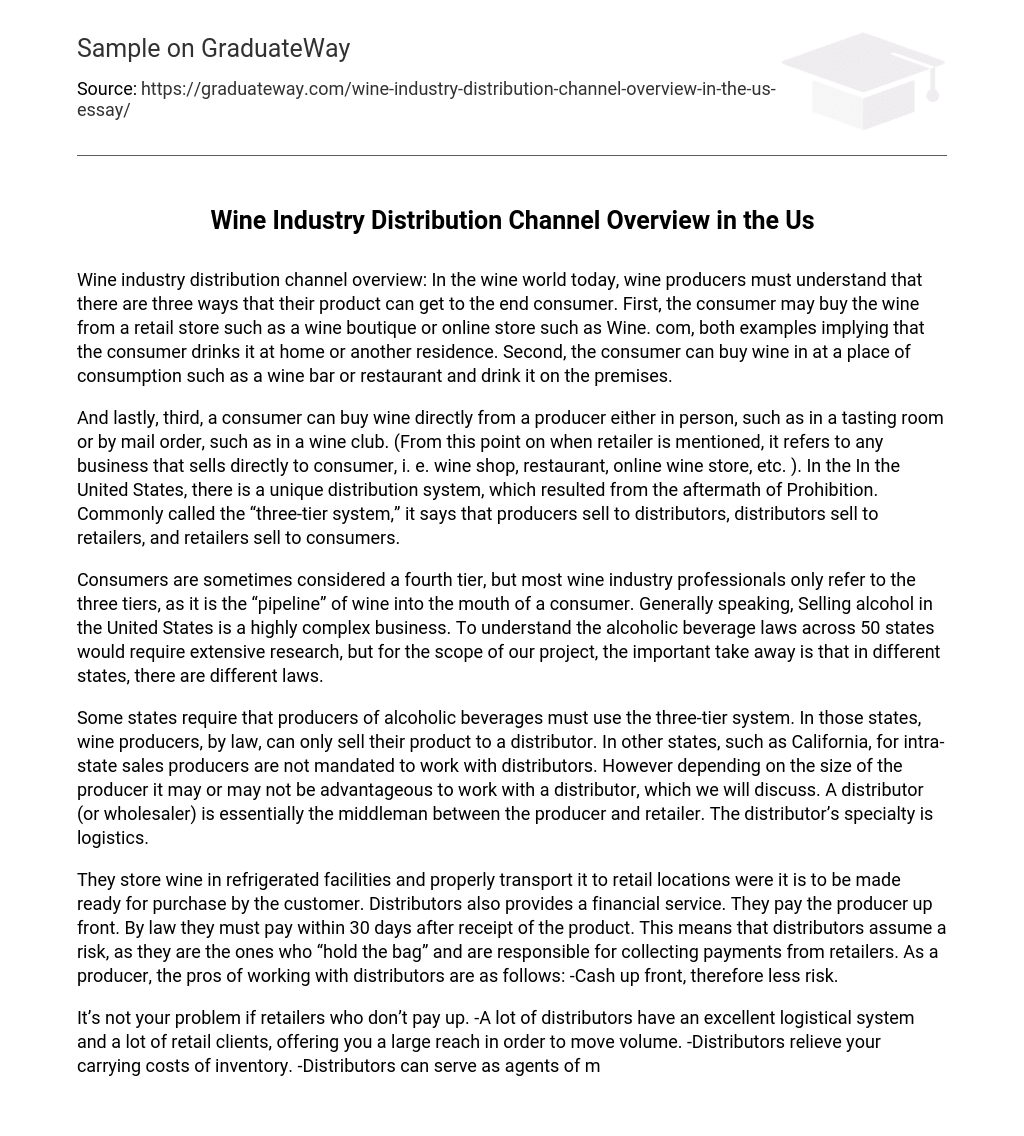Wine industry distribution channel overview: In the wine world today, wine producers must understand that there are three ways that their product can get to the end consumer. First, the consumer may buy the wine from a retail store such as a wine boutique or online store such as Wine. com, both examples implying that the consumer drinks it at home or another residence. Second, the consumer can buy wine in at a place of consumption such as a wine bar or restaurant and drink it on the premises.
And lastly, third, a consumer can buy wine directly from a producer either in person, such as in a tasting room or by mail order, such as in a wine club. (From this point on when retailer is mentioned, it refers to any business that sells directly to consumer, i. e. wine shop, restaurant, online wine store, etc. ). In the In the United States, there is a unique distribution system, which resulted from the aftermath of Prohibition. Commonly called the “three-tier system,” it says that producers sell to distributors, distributors sell to retailers, and retailers sell to consumers.
Consumers are sometimes considered a fourth tier, but most wine industry professionals only refer to the three tiers, as it is the “pipeline” of wine into the mouth of a consumer. Generally speaking, Selling alcohol in the United States is a highly complex business. To understand the alcoholic beverage laws across 50 states would require extensive research, but for the scope of our project, the important take away is that in different states, there are different laws.
Some states require that producers of alcoholic beverages must use the three-tier system. In those states, wine producers, by law, can only sell their product to a distributor. In other states, such as California, for intra-state sales producers are not mandated to work with distributors. However depending on the size of the producer it may or may not be advantageous to work with a distributor, which we will discuss. A distributor (or wholesaler) is essentially the middleman between the producer and retailer. The distributor’s specialty is logistics.
They store wine in refrigerated facilities and properly transport it to retail locations were it is to be made ready for purchase by the customer. Distributors also provides a financial service. They pay the producer up front. By law they must pay within 30 days after receipt of the product. This means that distributors assume a risk, as they are the ones who “hold the bag” and are responsible for collecting payments from retailers. As a producer, the pros of working with distributors are as follows: -Cash up front, therefore less risk.
It’s not your problem if retailers who don’t pay up. -A lot of distributors have an excellent logistical system and a lot of retail clients, offering you a large reach in order to move volume. -Distributors relieve your carrying costs of inventory. -Distributors can serve as agents of marketing research, as they are constantly interacting with the customers. They can become aware of trends and marketing problems before the producer because they are on the front lines. Naturally, there are cons of working with distributors: -They cut substantially into your profit margin. You have less control of where your product will become available. -You have little or no control of the selling price they charge. -Distributors work with many producers and it’s hard for salespeople to remember every winery’s story. They may get things wrong or do an improper impression of your brand. In states, such as California, the producer has the option to sell directly to a retailer/restaurant and also directly to the consumer. Direct sales to consumers is advantageous to a producer as that is where the highest profit margins are gained.
However, the challenge for the producers is reaching a mass market of consumers directly. The average wine consumer buys wine via the three methods described in the beginning of this section, so it could be to the producer’s advantage to employ a mix of distribution channels. Selling to a retailer, directly, is less costly than going through a distributor, but does cut into the producer’s profit margin. It also requires sales skills from the producer and a strong understanding of the retail market.
Larger producers have a sales force who are commissioned to sell to retailers, whereas smaller producers, the winemaker, him or herself, may be the salesperson. Both large and small producers can also hire a wine broker (not to be confused with a distributor or wholesaler). Wine brokers essentially facilitate transactions between the producer and the retailer and take a commission as payment. Unlike a distributor, they do not buy (or even touch) the product so therefore they assume no risk. They are basically hired salespeople.





